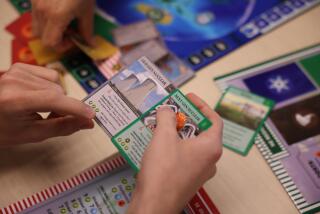New Computer Game Matches Moves With the Superpowers
In his first year in office, the President faced a crisis: He had sent $200 million in military aid to Taiwan, and now the Soviet Union was threatening to start a war. What began as a diplomatic crisis had quickly escalated, and both governments had their military forces on maximum alert. “This issue is of great concern to the Soviet government,” the President’s computer warned.
As President, Leonard Diiorio had two choices: To withdraw the aid or stand up to the Soviets. The former would cost him prestige in the eyes of the world; the latter would risk nuclear war.
“I have to prove to them that I’m not the kind of person who backs down easily,” Diiorio said, explaining his decision not to withdraw aid. He waited anxiously until the Soviet response appeared on his terminal: “The peace-loving U.S.S.R. refuses to begin a nuclear holocaust.” Diiorio sighed in relief.
This was a computer game, but it was far from an ordinary one. While most demand hand-eye coordination or created fantasy, Balance of Power offers an illusion based on reality: The opportunity to play President of the United States or general secretary of the U.S.S.R., and to influence world events through aid, treaties, diplomatic pressure, military intervention and other tactics. The second superpower--played by a human being or the computer--does likewise.
Balance of Power has been hailed by many reviewers, including David Aaron, a former national security adviser during the Carter Administration, who called it “the most sophisticated strategic simulation in America, other than Pentagon war games.” It is being used in undergraduate international affairs courses, recommended to a NATO committee, and is the subject of a forthcoming article in the Journal of Conflict Resolution, a prestigious academic journal published at Yale. All for a game that retails at about $45.
Officials at Mindscape Inc., the game’s publisher, say the company has sold about 60,000 copies of Balance of Power. (Certified sales of 50,000 merit a silver award from the Software Publishers Assn.) The game, which first went on the market in the fall of 1985, has attracted a loyal following: Last fall, Microsoft Press released “Balance of Power: International Politics as the Ultimate Global Game,” a 300-page trade paperback, which provides an introduction to geopolitics and an explanation of the game’s algorithms (internal logic).
The object of the game is to strengthen allies and weaken enemies, thus accumulating “prestige points”; the more powerful a country, the greater its prestige value. To win, a player must survive eight “years” (rounds) without a nuclear war.
The heart of Balance of Power is the type of crisis faced by Leonard Diiorio when he sent military aid to Taiwan: One superpower can object to the other’s initiative, first through diplomatic channels, then public challenges that involve more prestige and may lead to nuclear war. Once past the diplomatic stage, a player also risks accidental nuclear war.
Balance of Power is, by all accounts, an exceedingly difficult game to win. “I’m too aggressive,” said Scott Shuler, a professor of music education at Cal State Long Beach.
“When you put yourself in the position of the President or the general secretary, you really do feel responsible for your country,” says Diiorio, 34, a computer consultant who lives in Venice. “I like the concept that you have to be responsible for the fate of the earth.”
Computer Simulations
At work, ex-Army Capt. John Detroye III of Lawton, Okla., runs computer simulations of weapons for the Army; he says he enjoys the chance Balance of Power affords to play on a larger scale, and he approves of its combative politics. “The Soviets are a paranoid, frightened people,” Detroye said. “If you follow the course our country has taken since the Carter Administration, and make game decisions accordingly, the Soviets will take over (the U.S.) by 1997.”
Not everyone praises Balance of Power. In a recent issue of the Nation, a writer described the game as “a grimly accurate reproduction of the national security mind-set . . . an appropriation of cold war attitudes disguised as computer logic.”
Yet, others accuse the game of preaching pacifism, and peace groups have asked its creator to donate copies.
The creator of Balance of Power, Chris Crawford, is surprised by all the attention. “I thought that a typical college professor would say, ‘Rather simplistic,’ ” said Crawford, who, in conversation and print, is quick to point out his game’s failings. For example, Balance of Power portrays the world as a playground for two superpowers and ignores many elements, such as trade, that are important to world affairs.
Crawford compares the game to Zelig, the chameleon-like Woody Allen character who assumes the personality of those around him: Balance of Power, Crawford suggested, is a mirror that reflects a player’s political biases while occasionally challenging them. He said he “cannot identify with the left wing or the right wing, yet I can sympathize with both.”
“The thrust of the game is peaceful coexistence” said Crawford, 36, who lives in the foothills east of San Jose. “But there are some biases--and I was acutely aware of these--they tend to push it in a conservative direction. It does emphasize conflict. You can have peaceful coexistence with conflict--the idea that we can be tough with the Russians, if we just learn to fight fair. . . . But conflict is necessary to a game, so, regardless of my own biases, I had to have the conflict.”
For Crawford, the drive to create a geopolitics game verged on an obsession. Once a top game designer at Atari, he spent more than a year on Balance of Power, and almost lost his house when one publisher abandoned the project. Crawford traces its origins to the Vietnam War, when, as an “upper middle class, very sheltered, naive” 17-year-old, he watched his older brother go to war. His reaction, Crawford recalled recently, was “The supreme expression of rationalism--to try to understand war. I thought, if only we study it and come to understand it, we can eliminate it.” He designed several military games before Balance of Power.
Messianic Attitude
A physicist by education, Crawford has an almost messianic attitude toward game design: A game must entertain, of course, but it must also teach. And Americans, he contends, have much to learn about geopolitics: “We misused our military in Vietnam. We got sucked in, trying to defend ‘democracy’ or some other vague idealistic notion. We didn’t get our idealism; all we got were body bags. Balance of Power is ruthless in its punishment of ideological solutions to problems--the only thing it accepts is determined pragmatism. I very much hope that message gets across to players of any persuasion.”
Crawford is an unabashed elitist given to wearing faded jeans and work boots around his home, which offers a view of a valley, with downtown San Jose in the distance. When designing a game, he aims at a college-educated audience, but he intentionally excluded a “good sense” algorithm from Balance of Powers’ Soviet artificial intelligence; if the computer always made reasonable judgments, he contends, players would perceive this as weakness and take advantage by continually pushing the Soviets on small issues.
“A mature, otherwise reasonable adult will sit down at a game and ask, ‘How do I nuke the Russkies?’ ” Crawford said. “Part of this game is designed to say, ‘Nuke them and you die!’ The joy of play is experiencing things that you can’t experience in real life; there is an intrinsic loss of responsibility in that.”
In Venice, Leonard Diiorio was, by his own admission, “playing a dangerous game” in his third year as President. He sent $20 million of military hardware to Indonesia, military advisers to Burma, and combat troops to Nicaragua. “Don’t get me wrong,” he said. “I don’t know what I would advocate in a the real world.”
The Soviets objected first to the advisers in Burma. Diiorio and the computer went back and forth, both refusing to give in, until military forces were again at maximum alert. Diiorio had the same two choices: To withdraw the advisers or risk nuclear war. He refused to back down.
“The Soviet reply will arrive by ICBM,” the computer’s message read. For a moment, the terminal went blank, and a message appeared: “You have ignited a nuclear war. And no, there is no animated display of a mushroom cloud with parts of bodies flying through the air. We do not reward failure.”






